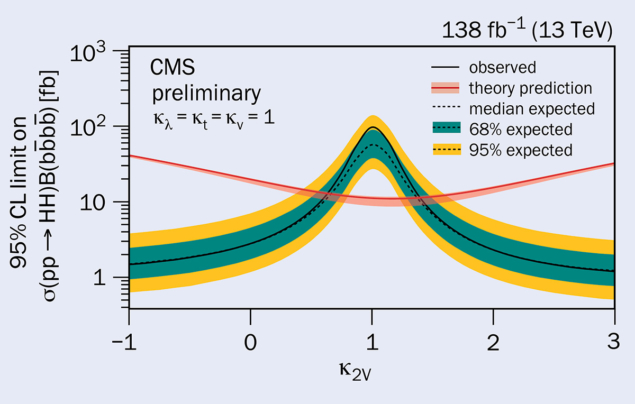A report from the CMS experiment.

Two fundamental characteristics of the Higgs boson (H) that have yet to be measured precisely are its self-coupling λ, which indicates how strongly it interacts with itself, and its quartic coupling to the vector bosons, which mediate the weak force. These couplings can be directly accessed at the LHC by studying the production of Higgs-boson pairs, which is an extremely rare process occurring about 1000 times less frequently than single-H production. However, several new-physics models predict a significant enhancement in the HH production rate compared to the Standard Model (SM) prediction, especially when the H pairs are very energetic, or boosted. Recently, the CMS collaboration developed a new strategy employing graph neural networks to search for boosted HH production in the four-bottom-quark final state, which is one of the most sensitive modes currently under examination.
H pairs are produced primarily via gluon and vector-boson fusion. The former production mode is sensitive to the self-coupling, while the latter probes the quartic coupling involving a pair of weak vector bosons and two Higgs bosons. The extracted modifiers of the coupling-strength parameters, κλ and κ2V, quantify their strengths relative to the SM expectation.
This latest CMS search targets both production modes and selects two Higgs bosons with a high Lorentz boost. When each Higgs boson decays to a pair of bottom quarks, the two quarks are reconstructed as a single large-radius jet. The main challenge is thus to identify the specific H jet while rejecting the background from light-flavour quarks and gluons. Graph neural networks, such as the ParticleNet algorithm, have been shown to distinguish successfully between real H jets and background jets. Using measured properties of the particles and secondary vertices within the jet cone, this algorithm treats each jet as an unordered set of its constituents, considers potential correlations between them, and assigns each jet a probability to originate from a Higgs-boson decay. At an H-jet selection efficiency of 60%, ParticleNet rejects background jets twice as efficiently as the previous best algorithm (known as DeepAK8). A modified version of this algorithm is also used to improve the H-jet mass resolution by nearly 40%.
Using the full LHC Run-2 dataset, the new result excludes an HH production rate larger than 9 times the SM cross-section at 95% confidence level, versus an expected limit of 5. This represents an improvement by a factor of 30 compared to the previous best result for boosted HH production. The analysis yields a strong constraint on the HH production rate and κλ, and the most stringent constraint on κ2V to date, assuming all other H couplings to be at their SM values (see figure 1). For the first time, and with the assumption that the other couplings are consistent with the SM, the result excludes the κ2V = 0 scenario at over five standard deviations, confirming the existence of a quartic coupling between two vector bosons and two Higgs bosons. This search paves the way for a more extensive use of advanced machine-learning techniques, the exploration of the boosted HH production regime, and further investigation into the potentially anomalous character of the Higgs boson in Run 3 and beyond.
Further reading
CMS Collab. 2021 CMS-PAS-B2G-22-003.
CMS Collab. 2021 CMS-DP-2020-002.
CMS Collab. 2020 JINST 15 P06005.








